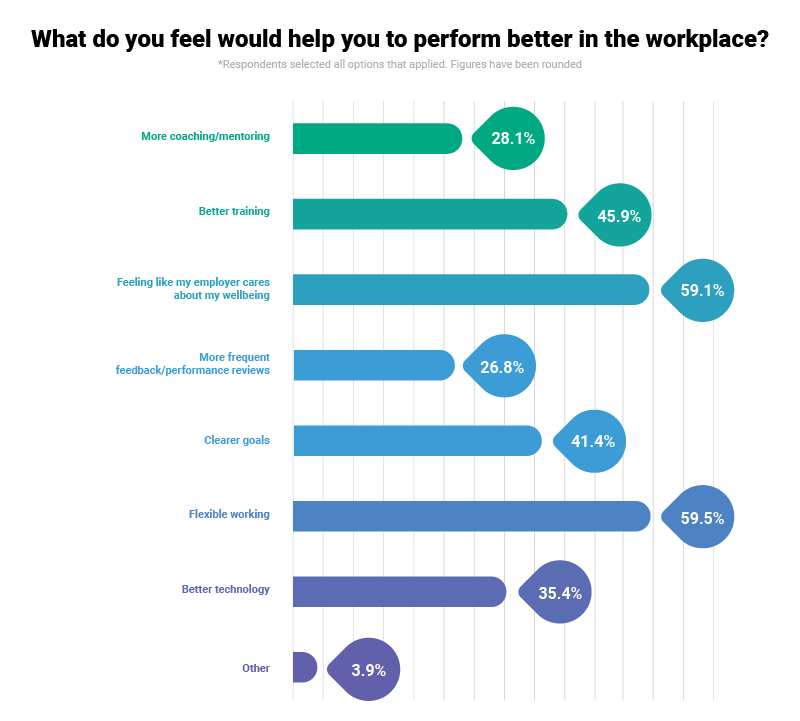Enabling employee engagement through performance management
Performance management is a perennial topic within the wider employee engagement conversation.
The latest Labour Market Outlook survey by the CIPD (Autumn 2019) anticipates 86% of employers reviewing pay over the next year, with 48% considering pay increases. So, there are a significant number of employers who will need to find motivators other than pay increases to engage their employees in 2020.
Download PDF
A key piece of the engagement puzzle is performance management. To understand the current state of performance management in the UK, Cezanne surveyed 1000 UK employees. The respondents came from across the private and public sectors, and a wide range of industries, and were asked about their experiences with and attitudes towards performance management.
The survey revealed some interesting insights about frequency of reviews, how they are recorded and attitudes towards reviews overall. Understanding and capitalising on these results will help you as an employer to positively engage with your people.
Frequency: ideal state versus reality
For some time now, the HR profession has been touting the benefits of ‘continuous performance management’. Cezanne’s HR platform supports this approach with the ‘Check-ins’ module that allows for the recording and following up of ongoing conversations and goals.
Two of the main selling points for continuous performance management are that concerns can be addressed quickly, and employees have the reassurance that they won’t get to the ‘annual’ review and encounter nasty surprises.
So, it’s surprising that the survey revealed that:
• The frequency of reviews for most respondents is annual (37.58%), and
• 54.48% of respondents had gone more than a year without documented performance feedback in their career.
More interesting still is that most people think performance reviews should take place annually (35.8%) followed by respondents who think they should be quarterly (27.59%).
As HR professionals, do we need to be doing more to promote the benefits of ongoing performance conversations? Or, is the clue in how these conversations are being administered?

Performance reviews: an administrative nightmare?
Unfortunately, the first thing most people think about when envisioning performance reviews is still a mountain of paperwork. Despite the global shift to an ever more technologically advanced workplace, HR seems to be lagging behind.
Our survey reported that:
• most reviews are documented in printed form (41.79% of respondents)
• followed by Office software, such as Word, Excel, Google Docs etc. (23.75%), then
• an Online performance or HR software system (20.72%).
More worrying still, 14.1% of respondents had never had a documented performance review at all.

What do your people think?
Your people are at the coalface of performance management – both being managed and managing people themselves.
Are your people maximising the opportunities that performance management presents?
Businesses need to take note of our survey, that shows:
• most people are indifferent towards their reviews (33.06%), and
• respondents who answered why they dread reviews, said it is because the process is uncomfortable (40.43%), or a waste of time (26.95%).

Why some respondents dread performance reviews?
The results are not all doom and gloom. Respondents also revealed what can be done to improve the performance management process and make conversations more productive.
To improve performance reviews, the top responses were:
• more focus on career opportunities and training, and
• more focus on future goals and objectives.

The survey also provides insight into what respondents are comfortable discussing in a performance review, with work/ life balance (71.8%) the top personal issue people would open up about.

Performance management: it’s not all about ‘outputs’
The tick-boxing approach to performance management, with the employee sitting across from their manager reviewing a list of tasks, is ready for an overhaul. Just as soft skills are being more and more valued in new hires, soft management skills are also essential. An interest in your employee goes a long way in building engagement.
Respondents revealed that ‘flexible working’ (59.5%) and ‘feeling like my employer cares about my wellbeing’ (59.1%) are the top things people think would help them perform better – both reasonable requests that are par for the course in the modern workplace.

Improve your performance management with HR tech
Using the right technology from the outset allows employers to establish a robust performance process for the whole employee lifecycle. By connecting with your new hire via a professional HR system, you’re demonstrating that you have an organised and modern approach to people management.
Future performance management processes, facilitated by your HR system, build on this initial impression by documenting, communicating and organising goals for your employees. HR, line managers and your people all benefit from a system that supports less admin and provides an opportunity for more frequent check ins.

Start as you mean to go on
Is your workplace ready to have more productive performance conversations with their employees? Your opportunity to engage with your staff and manage their performance starts with onboarding.
We asked respondents how well they felt they were onboarded at their organisation. 42.6% were onboarded well, and 18.5% very well.

There is clearly an opportunity here for employers to improve their onboarding experience.
HR technology, like Cezanne’s Onboarding software, allows HR and line managers to start the relationship with new hires on the right note. Once a new hire is confirmed, the employer can send them a link to a dedicated welcome page.
The page can be tailored and might also include a checklist of what the new employee needs to do ahead of their start date.
This onboarding feature can then be used for other employment milestones, such as returning to work after an absence or off boarding. The tool helps HR and line managers engage with staff while keeping HR processes on track.

Performance management is integral to your business – it sets the stage for employee engagement and ultimately workforce productivity. Cezanne works with customers across the globe to engage with tens of thousands of employees.